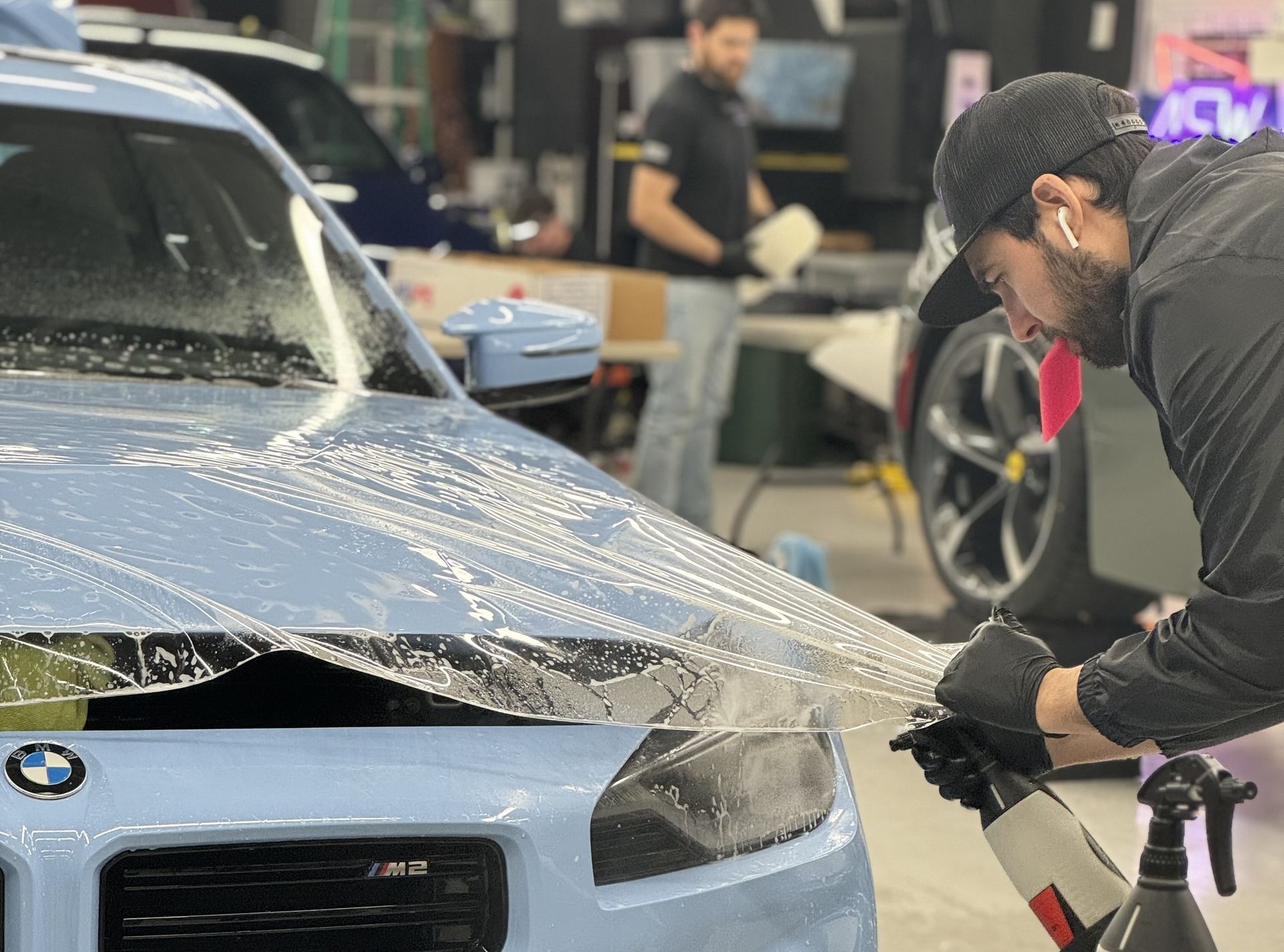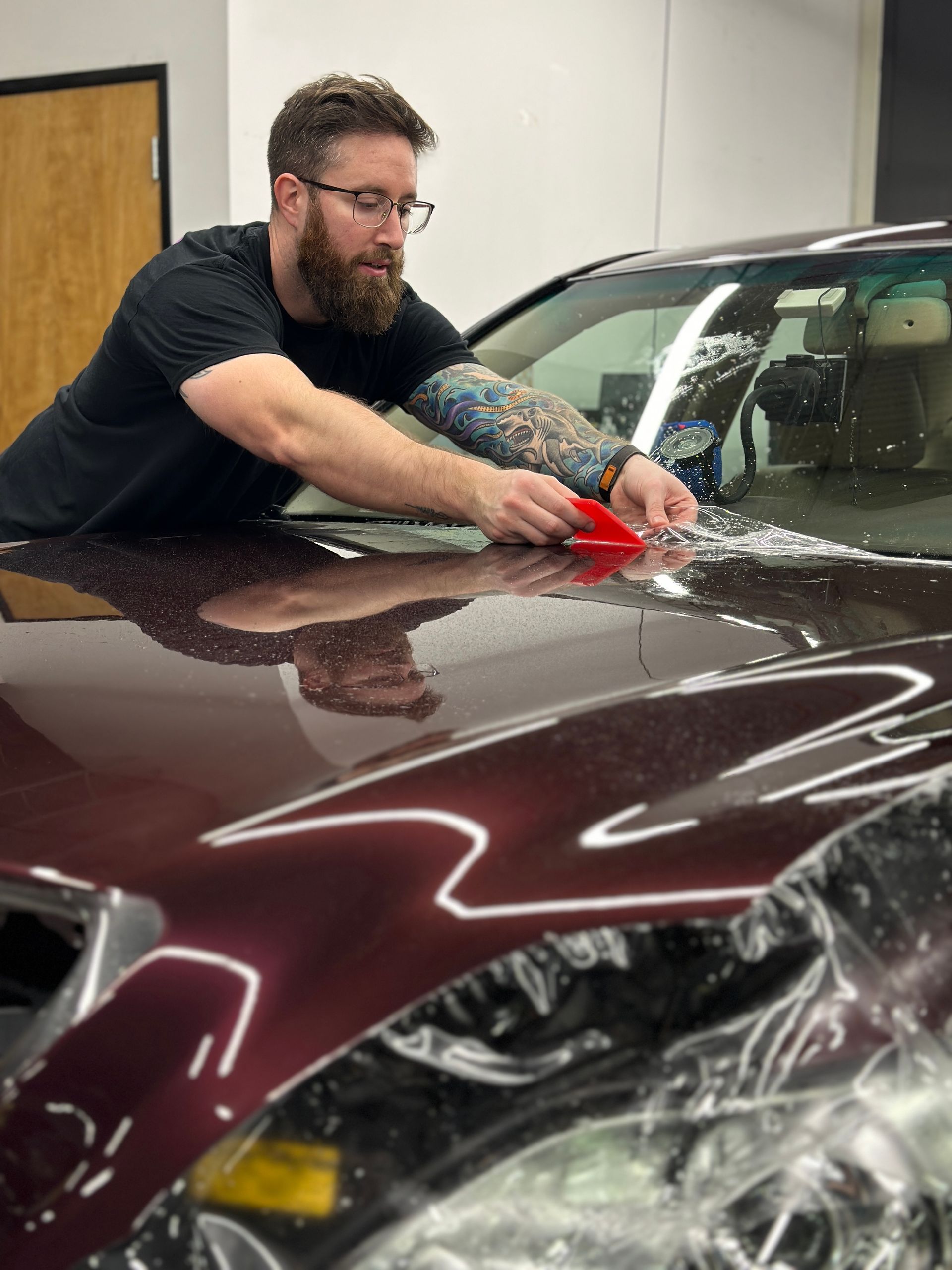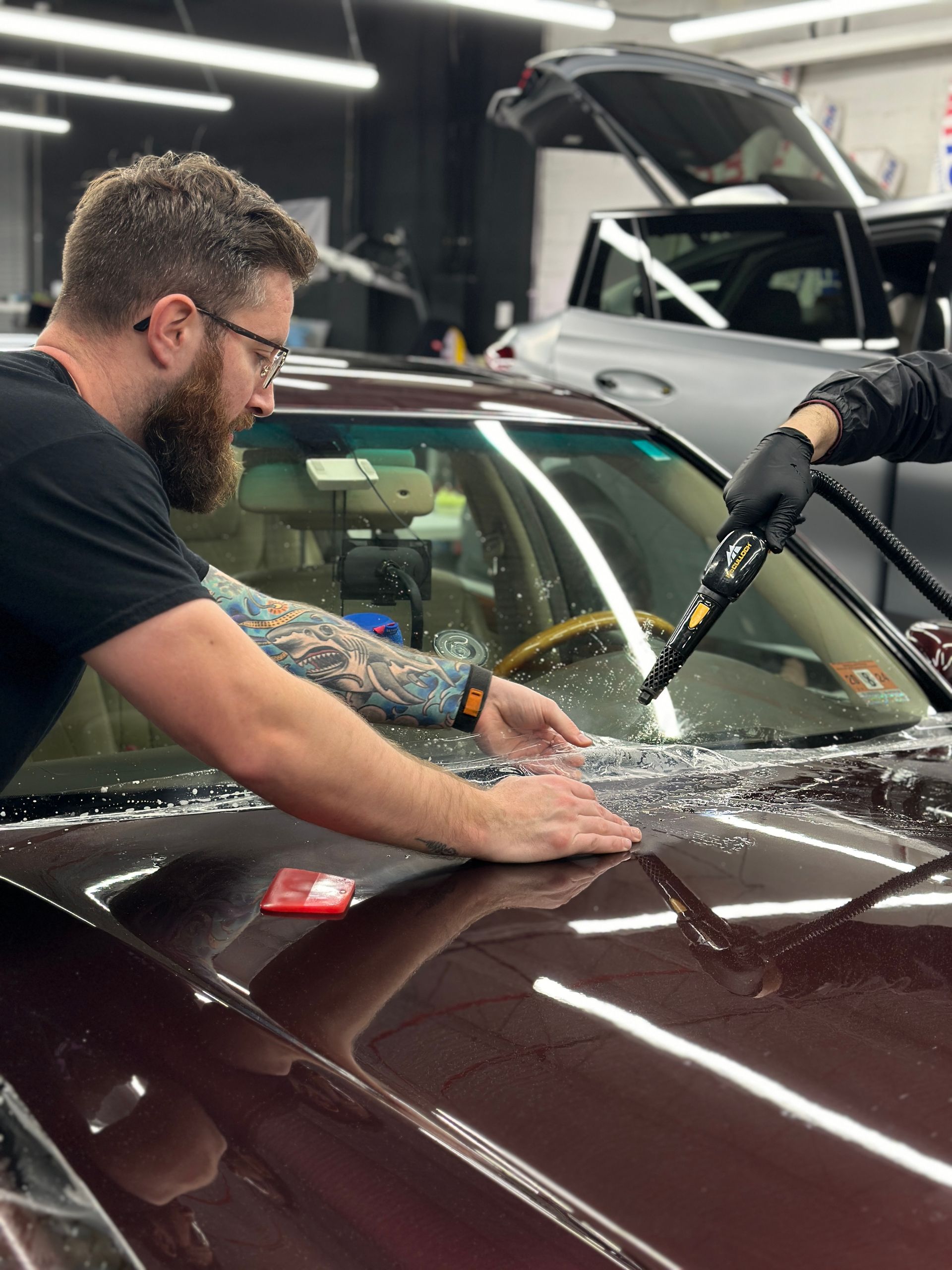Expert PPF Installers: How They Handle Curved Panels and Body Lines with Precision
GET A FREE ESTIMATEWhen it comes to protecting your vehicle's paint, applying paint protection film (PPF) might seem as simple as sticking a clear layer on the surface. But anyone who's worked with these films knows that wrapping a car—especially around curved panels and body lines—is far from straightforward. The way the film stretches, bends, and adheres takes skill and careful technique to avoid bubbles, wrinkles, or peeling later on. That's why expert installers approach each car with precision, using the right tools and methods to keep your paint safe while preserving your vehicle's sleek appearance. Expert PPF installers use precise heat application, strategic stretching techniques, and meticulous hand finishing to conform the film smoothly over complex curves and contours. They rely on computer-cut patterns combined with careful trimming and adhesion mastery to ensure a flawless, durable finish that preserves both protection and your vehicle's aesthetic appeal.
The Challenge of Curved Panels
Curved surfaces on vehicles—from softly rounded fenders to sharply sculpted door edges—pose significant challenges for PPF installers. Unlike flat panels, these surfaces require the film to stretch, bend, and adapt without losing its protective integrity or optical clarity. The first crucial step in managing these surfaces is temperature control. Professional installers use calibrated heat guns to gently warm the film so that it can stretch over complicated shapes. Precise temperature application is essential—when executed correctly, this softening allows the film to become flexible without compromising its strength or structure. Overheating can cause distortion or lingering stress within the film, whereas insufficient heating results in poor adhesion and inadequate stretch. Equally important is the controlled stretching technique installers use during application. Starting from the center of a curved area and working outward distributes tension evenly across the film. This method stops localized thinning or warping, which makes protection less effective over time.
Carefully balancing how far the film is stretched is another delicate consideration—pushing beyond the material's limits risks permanent deformation and loss of protective properties. Installers complement heat and stretch tactics with the wet installation method, applying a slip solution to both the vehicle surface and adhesive side of the film. This liquid layer allows repositioning for perfect alignment, especially critical on edges and tight curves where precision matters most. Once positioned, specialized squeegees with felt edges carefully expel trapped air bubbles while protecting the paint surface beneath. An often overlooked detail is how installers handle edges on curved panels. Experienced professionals perform "tucking" techniques, discreetly guiding the film into crevices without folding it completely over hard edges. This approach maintains durability and prevents premature failures common with aggressive edge wrapping. Installation times vary depending on curve complexity. While a relatively simple hood panel might take around twenty minutes, tight fender curves and multi-dimensional bumper shapes can require forty-five minutes or more per section, emphasizing care over speed.
Why Curved Panels Demand Professional Expertise
The very curves that make modern vehicles visually striking create multiple technical hurdles during PPF application. First and foremost is the challenge of tension and distortion. If tension is uneven or misdirected, the film can warp or distort, creating unwanted waves or wrinkles that compromise both appearance and protective qualities. This directly leads to adhesion concerns. Unlike flat surfaces where the film sits naturally flush against the paint, curved areas require installers to coax the film into contours that resist uniform contact. The slightest gap or fold can reduce adhesive bond strength, making those spots prone to lifting over time. Achieving the fine balance between flexibility and adhesion often requires multiple heating cycles across a single panel.
Another persistent problem is air bubble formation. On complex curves, air pockets can hide deep within folds or creases if smoothing isn't meticulous. This technique demands patience—a single hurried pass risks sealing bubbles under the surface, leading to premature peeling and unsightly blemishes. The physical properties of PPF dictate limited elongation capacity. Stretching beyond that threshold thins certain areas of the film unevenly, degrading durability exactly where protection is most critical—around tightly curved edges like fender lips or bumper corners. Compromised thickness can accelerate wear from debris impact or environmental exposure. These intertwined challenges explain why installing PPF on curved panels requires professional experience and technical knowledge. Top-tier professionals work in sections rather than trying to cover complex shapes in one pass, allowing them to focus precisely on each contour without rushing.
Precision Application Techniques
Precision forms the very foundation of effective PPF application, especially when dealing with the complex curves and body lines found on today's vehicles. The process begins long before the film touches the car's surface—it starts with creating patterns that fit each model with exactness. Professional installers rely on computer-controlled plotters to cut these patterns with extraordinary accuracy. This technology allows them to produce film shapes that conform exactly to the unique contours of hoods, fenders, and bumpers, reducing waste and eliminating guesswork.
However, technology alone can't address every nuance. Complex transitions between panels or sharp body creases often challenge even the best digital cutters. That's where manual trimming becomes indispensable. Skilled installers wield razor-sharp blades with deliberate care to trim excess film neatly along edges and into tight corners. This step demands patience and experience—a single slip could mar the finish or weaken the protection. The precision required is similar to tailoring fine clothing, where straight lines won't suffice when curves demand delicate attention. Targeted hand trimming helps hide seams invisibly across adjoining panels, maintaining your vehicle's aesthetic unity. It also enables installers to "tuck" the film where needed—a technique whereby edges are gently folded beneath adjacent panels rather than wrapped over sharp edges that risk peeling later. This controlled approach balances durability with appearance, extending protection lifespan while keeping every detail tight and clean.
Achieving Perfect Edges and Seamless Coverage
Achieving perfect edges and seamless coverage is a craft honed over years of practice. Even a minute flaw—a tiny bubble or an uneven edge—can stand out sharply on your vehicle's finish, undermining the sleek, invisible protection that PPF promises. The critical tool in this process is the squeegee, specifically one designed with felt edges. These tools delicately press the film onto complex curves, eliminating trapped air without damaging the adhesive layer. The technician methodically works from the center outward toward the edges, ensuring tension distributes evenly and film thickness remains consistent.
Professionals apply targeted adhesion promoters along vulnerable borders and use edge sealants, especially around high-stress zones like fender flares, wheel wells, and door jambs. These areas are prone to lifting due to constant exposure to road debris, moisture, and temperature fluctuations. By sealing these edges carefully, installers dramatically reduce premature film peeling and dirt intrusion. The sealing process involves gentle heat application followed by precise finishing. Installers use heat guns calibrated for just the right duration at each section of the edge. This warming softens the film just enough to shrink it snugly against contours without overstretching or weakening its structure. Once warmed, the edge is pressed firmly to activate the pressure-sensitive adhesive fully, forming a durable bond between the film and the paint surface. Skilled installers divide complex panels into manageable sections for sequential application, ensuring no shortcuts compromise edge quality. After application, vehicles typically require a curing phase under controlled conditions before use, allowing adhesive bonds to mature fully.
Mastering Body Lines with Strategic Sectioning
Body lines on modern vehicles define a car's character and fluidity. Yet these sharp transitions and sculpted contours pose serious challenges when applying PPF. The tight creases and angles force installers to be incredibly precise, because any undue stretching or misalignment can cause distortion, bubbles, or premature lifting. Expert installers rarely try to cover an entire complex surface with one large piece of film. Instead, they break down sweeping curves or intricate ridges into smaller sections. This strategic sectioning allows them to focus on each segment individually, adjusting tension and heat application carefully without compromising the film's integrity. This approach requires patience and skill.
Aligning each piece perfectly along body lines ensures invisible seams and maintains your vehicle's flawless finish. When done well, the seams practically disappear to the naked eye, preserving both appearance and protection. Strategic sectioning means dividing complex areas—like hood contours, fender bulges, or bumper corners—into manageable parts for installation. Working in sections reduces stress on the film's adhesive bond by minimizing excessive stretching. By carefully tucking and layering sections where body lines intersect, professionals preserve the thickness and durability of the film. This technique works hand-in-hand with precision cutting. By using computer-controlled plotters along with expert hand-trimming, installers can make patterns that follow the car's natural lines, creating a smooth look and improving the film's protection against chips and scratches.
The Professional Difference
Mastery of PPF installation is where craftsmanship truly shines. Experienced professionals blend technical knowledge—understanding material stretch limits and adhesive activation—with artistry in pattern matching and heat-shaping techniques. Perfecting PPF application around curves and body lines isn't about rushing or brute force. It demands thoughtful segmentation, careful tension control through heat application, and meticulous alignment of individual pieces so that durability and invisible protection work together. This careful methodology separates professional-quality installations from amateur attempts. Expertise in handling curves and body lines transforms PPF from mere protection into precision work that enhances both function and style. Trusting skilled professionals ensures your vehicle stays flawless against physical challenges while maintaining its sleek design integrity—delivering the showroom-quality finish you deserve.
Advanced Paint Protection Film in Hawthorne, NJ
Automotive Specialty Wraps in Hawthorne, NJ offers
top-tier paint protection film that helps your vehicle stay showroom-ready year after year. Our certified technicians apply cutting-edge film that resists damage from rocks, salt, and UV rays while enhancing your car’s natural shine. With precise installation and long-lasting results, your investment stays protected from the elements.
Schedule your PPF installation today to keep your vehicle looking its best on every drive!






